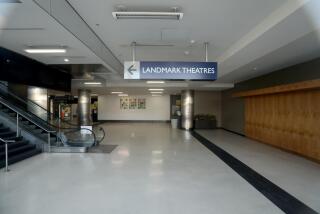UCLA and Art of Landscape Architecture
- Share via
The new child-care center at UCLA is tucked into a small glen in the northwest corner of the Westwood campus, near the intersection of Sunset Boulevard and Bellagio Road.
Despite a streamlined look befitting its modular, pre-engineered construction, the center is a relatively modest building that promises to be veiled by landscaping when the plantings are completed and mature.
Lushly designed by the office of Emmet Wemple, the landscape plan calls for more than 50 trees, including sycamores, eucalyptuses and ginkos--some new and others replacing those that had to be cut down to make way for the construction.
The plan is very much in keeping with the frayed tradition of the UCLA campus as both an open and inviting park and as a botanical laboratory of sorts, where many rare and unusual plants and trees have been used as hedges, screening and focal points.
As for the 8,500-square-foot center’s relationship to the landscaping, it has been sensitively sited by the architecture team of Charles and Elizabeth Lee in a horseshoe configuration to orient the classrooms to the outdoors and provide a secure play area for the children. Welcome also is the extensive use of glass, scaled to allow the children to see out.
While the center itself is closed to visitors, the building and its grounds can be viewed from the curving access road off Bellagio Road.
What happily is not closed is the UCLA campus. It is a delight to tour, especially on a weekend when driving and parking are relatively easier than on weekdays, though not cheaper. You can park either in Westwood or in a campus garage, the latter for $3.
Various courtyards, quadrangles and patios are linked by pedestrian paths, making it a pleasure for anyone with a child or children in tow--one can walk and enjoy the grounds without worrying too much about traffic. And then there are the lawns and steps, for the children to run across and up and down, and tire themselves out.
There are a few buildings of architectural distinction at UCLA, in particular the richly brick-and-stone-detailed quartet of Italian Romanesque-style structures edging Dickson Plaza. These include Royce and Kinsey halls, both designed by Allison & Allison in 1928 and 1929, and Powell Library and Haines Hall, designed by George Kelham in 1928 and 1938, respectively. Together they form a romantic image of academia, with Royce and its arcades and arches, inscriptions and embellishments the most engaging.
However, what really distinguishes UCLA is its landscaping, as fashioned for the most part by Ralph Cornell, who served as the school’s landscape architect for nearly 40 years until his death in 1972.
Much of Cornell’s inspired plantings have somehow survived, despite some terrible planning errors by others. These include some badly designed buildings and awkward sitings, such as the incursion of a bland dormitory slab into the axial view west from Dickson Plaza and the Janss steps.
But lessening that distraction are incense cedar trees on each side of the Janss steps, as well as nearby Italian stone pines, and a few magnificent cypresses. A marvelous spot is between Haines and Royce halls, where there are two large California Christmas trees, which are really natives of the Himalayas. Supposedly they were among the first plantings on campus.
Almost everywhere you look in the central part of the campus in and around Dickson Plaza, there are plantings that catch the eye: a giant yucca and a Mediterranean fan palm on the south side of the Humanities building; a couple of mature olive trees at the east entrance of Haines Hall; several star magnolias and a Senegal date palm on the west side of Schoenberg Hall; several varieties of eucalyptuses, including a great silver-dollar gum and a pink-flowered whitewood on the east side of Boelter Hall.
To view even more exotic native plants, there is the Mildred Mathias Botanical Garden, tucked away in the southeast corner of the campus. It is used as a living laboratory for the teaching of biology and is open to the public, weekdays 8 a.m.-5 p.m. and weekends, 10 a.m.-4 p.m.
And while you don’t need to know the name of the tree or bush to appreciate them, most are labeled, both in the garden and on the campus.
Some years ago UCLA published a pamphlet called “The University Garden,” which detailed much of the plantings on the central campus and suggested four tours, each beginning at Dickson Plaza. Unfortunately, the pamphlet is out of print so any tour of the botanical campus must be self-guided. The labelings help a great deal, and also allow you to walk at your own pace.
There are scheduled general tours of the campus that begin at the Ueberroth Building, 1045 Le Conte Ave., at 10:30 a.m. and 1:30 p.m. weekdays. For group or weekend tours, and for more information, those interested are asked to call (213) 206-8147. There also is a detailed map entitled “Seeing UCLA,” which can be obtained free at the information and parking booths at the main entrances to the campus.
More to Read
The biggest entertainment stories
Get our big stories about Hollywood, film, television, music, arts, culture and more right in your inbox as soon as they publish.
You may occasionally receive promotional content from the Los Angeles Times.










